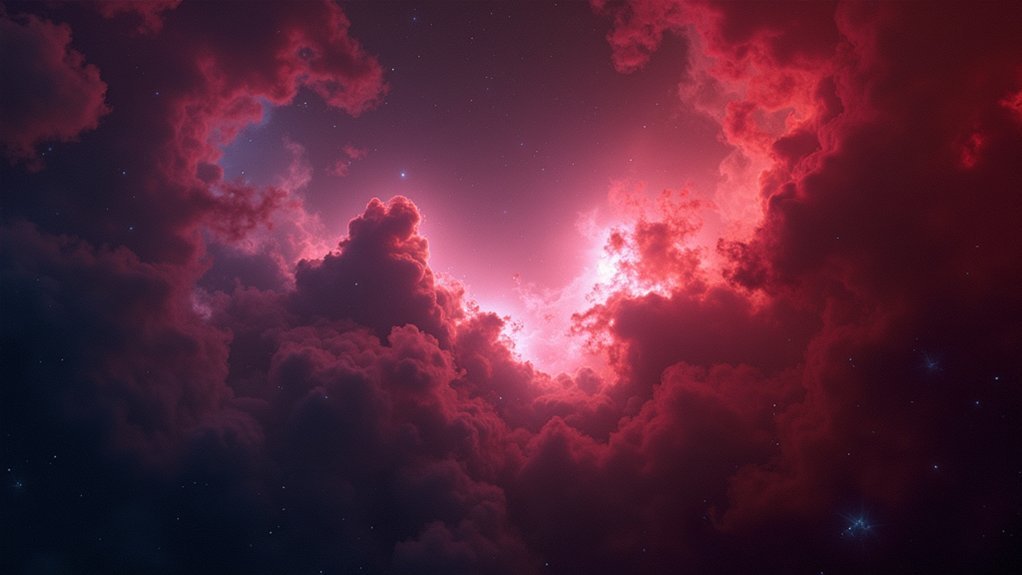For beginner astrophotography with a standard DSLR, try the Orion Nebula (135-300mm lens, January viewing), Lagoon Nebula (200mm lens, summer nights), North America Nebula (wide-field imaging, any basic DSLR), Andromeda Galaxy (50-200mm lens, 15-30 second exposures), and Heart and Soul Nebulae (200mm lens, fall/winter). You’ll need a sturdy tripod, longer exposures, and image stacking software. These celestial targets offer the perfect balance of accessibility and stunning results for your cosmic journey.
The Orion Nebula: A Stunning Winter Showcase for DSLR Photographers

While many deep-sky objects challenge beginners, the Orion Nebula stands out as an exceptional first target for DSLR astrophotography. Located just 1,344 light-years away, this bright celestial wonder spans 24 light-years and reveals stunning details even with modest equipment.
You’ll capture the best results using a focal length between 135-300mm, focusing on the nebula’s bright core and swirling gas clouds. For ideal clarity, shoot during January when the nebula reaches its highest point in the night sky.
To maximize image quality, escape light pollution by driving to dark skies. Then take multiple exposures of the same area. Later, use image processing software to stack these frames, dramatically reducing noise and revealing delicate structures that single shots can’t capture.
Capturing the Lagoon Nebula’s Vibrant Details With Basic Equipment
The Orion Nebula offers winter astrophotographers a magnificent target, but as summer arrives, the Lagoon Nebula (M8) takes center stage as another exceptional beginner-friendly object.
As seasons shift, summer skies reveal the beginner-friendly Lagoon Nebula where winter once showcased Orion’s splendor.
Located in Sagittarius, this bright nebula reveals its intricate structures even with modest equipment.
You’ll get the best results using a DSLR with at least 200mm focal length and a fast lens (f/2.8 or lower) to collect more light.
Mount your camera on a sturdy tripod for stability during long exposures, or add a star tracker to prevent star trails and capture more detail.
Plan your shoot during July and August when the Lagoon Nebula reaches peak visibility.
After capturing your images, use software like DeepSkyStacker and Photoshop to enhance contrast and bring out the vibrant colors of this stunning astrophotography subject.
North America Nebula: Wide-Field Imaging on a Limited Budget

Located in the summer constellation Cygnus, the North America Nebula offers an ideal target for beginners with limited equipment due to its large size and distinctive shape. You’ll find this emission nebula particularly rewarding for wide-field imaging using entry-level gear.
| Equipment | Recommendation |
|---|---|
| Camera | Canon EOS Rebel or similar DSLR |
| Lens | Fast lens (f/2.8-f/4) |
| Support | Stable tripod or tracker |
| Filter | Light pollution filter |
| Exposure | 30 seconds to several minutes |
For the best details, seek clear dark skies away from city lights. If that’s not possible, a quality light pollution filter will enhance contrast dramatically. Your long exposures will reveal delicate structures invisible to the naked eye. The nebula’s continent-like shape makes it easily identifiable even in beginner astrophotography attempts, especially when captured with a wide-field setup.
The Andromeda Galaxy: Beyond Nebulae for Easy DSLR Success
Moving beyond emission nebulae, our next stellar target offers some of the most rewarding results for beginner astrophotographers. The Andromeda Galaxy, just 2.537 million light-years away, is perfect for your DSLR’s capabilities. At magnitude 3.4, you’ll spot it easily under dark skies.
For capturing this deep-sky image, use a focal length between 50-200mm to frame the galaxy properly. Mount your camera on a stable photography tripod and try long exposures of 15-30 seconds to gather detail while minimizing star trails.
You don’t need expensive equipment to get started! Improve your results with image stacking techniques during post-processing. This reduces noise and enhances subtle features.
Andromeda’s proximity and brightness make it an ideal confidence-building target as you develop your astrophotography skills.
Heart and Soul Nebulae: Perfect Targets for 200mm Lenses

Among the most enchanting deep-sky objects for DSLR astrophotographers, the Heart and Soul Nebulae stand out as ideal targets when you’re ready to expand your portfolio.
Located in Cassiopeia about 7,500 light-years away, these vibrant nebulae offer stunning wide-field shots with your 200mm lens.
You’ll achieve best results during fall and winter nights when they climb high in the night sky, minimizing atmospheric distortion.
Their substantial size—105 and 70 light-years across respectively—means you can capture both nebulae without excessive cropping.
For excellent results, use a lens with a fast focal ratio between f/2.8 and f/4.
This allows for longer exposures that reveal the delicate structures and rich star fields surrounding these celestial gems.
Their vibrant colors make them particularly rewarding for DSLR astrophotography beginners.
Frequently Asked Questions
What Is the Easiest Nebula to Photograph?
For the easiest nebula to photograph, you’ll want to start with the Orion Nebula (M42). It’s exceptionally bright, visible during winter months, and you’ll capture impressive details even with basic DSLR equipment.
Can You Do Astrophotography With Just a DSLR?
Yes, you can definitely do astrophotography with just a DSLR. Modern DSLRs have excellent sensors that capture enough light for celestial objects, especially when you’re using fast lenses and a stable tripod.
What Is the Easiest Astrophotography Target?
The easiest astrophotography target is the Orion Nebula (M42). You’ll find it bright and visible even from light-polluted areas during winter months. It’s perfect for capturing with just your DSLR camera.
How Do I Set up My DSLR for Astrophotography?
For astrophotography setup, use manual mode with ISO 800-1600, wide aperture (f/2.8-5.6), and 15-30 second exposures. Don’t forget a remote shutter release and shoot in RAW format for better post-processing flexibility.
In Summary
You’re now ready to begin your nebula photography journey! These five targets are excellent starting points that don’t require expensive specialized equipment. With your standard DSLR, suitable lenses, and perhaps a tracking mount, you’ll capture breathtaking cosmic wonders from your backyard. Remember to practice patience with your exposures and processing techniques. Soon, you’ll develop the skills to explore even more challenging deep-sky objects!





Leave a Reply